Attention "dusty"!
This article is already a little outdated and may contain information that no longer corresponds to the current status of the topic.
The SEOs of the world are aware that there are hard facts for this: Backlinks, domain popularity, keywords, term usage in the SERP snippet etc. But we believe that there are also very soft factors that influence the ranking. The "soft" factors that are taken into account here are search intent, page structure, content (text and non-text), scope, readability and the degree of specialization of the topic. This collection of factors is based on Rand Fishkin's Whiteboard Friday on "How Google may analyze and evaluate the Quality, Value, & Rank-Worthiness of Your Content".
However, as there are also hard factors, backlink count, term usage in the SERP snippet and WDF*IDF analyses as well as the Trust and Power*Trust of the respective domains were also included.
The following tools were used:
- moz bar extension for Chrome
- OnPage.org WDF*IDF tool
- Linkresearchtools QBL
For our test, we examined the first 10 search results in each case. As keywords we used
- chia seeds
- chia seed recipes
as keywords because we were interested in how Google deals with the different search intentions. In the analysis, we looked at the following characteristics and criteria:
- Term usage in the SERP snippet and in the content
- Intention of the results page
- Website type or provider type
- Backlink count of the page and domain (according to link research tool QBL)
- Trust and Power*Trust of the domain (according to QBL link research tools)
- Page layout, structure, text length, format and visuals (non-text elements)
- Word count, scope, specification and readability (WUSL)
1. KEYWORD USAGE
Pages no longer rank for keywords per se, but for topics. Search engines are now so adaptive that they can make semantic connections between terms and thus deduce the topic of a page. This resulted in keyword sets that we were able to pull from Google Suggest and the WDF*IDF analyses:
"chia seeds"
Google Suggest: recipes, dm, wikipedia, buy, healthy, calories, pudding, bread
WDF*IDF terms: chia, hispanica, seeds, salvia, superfoods, superfood, flaxseed, fatty acids, fiber, nutrients, omega, soak, antioxidants, daily requirement, grains, digestive, grains, side effects, consumption, ground, blood sugar level, heartburn, calcium, ingredients, linolenic acid, pudding, carbohydrates, fit, cholesterol level, tablespoon, vitamin, detox, chia oil, nutrition
"chia seed recipes"
Google Suggest: bread, muesli, savory, thermomix, dessert, lowcarb, pdf, vegan, slimming
WDF*IDF terms: chia, seeds, almond milk, superfoods, superfood, pudding, carpaccio, tablespoon, recipes, carb, cup, recipe images, satiety, smoothie, topping, puree, flaxseed, hempseed, snacks, stir, sesame, preparation, yogurt, fatty acids, shake, ingredients
This already shows that Google is able to recognize the topic. "chia seeds" is a generic keyword: no clear search intention can be identified here. Google suggests using Suggest to refine the search directly. If you want to rank for such a generic keyword, the best approach in this case is to focus on the term itself (e.g. via a definition) and remain general with the content as a whole.
With "chia seed recipes", on the other hand, it is clear that it is about preparing food with chia seeds. Basic information about cultivation, origin, etc. is of less interest here. The keyword set is correspondingly more differentiated.
We use the keyword sets to analyze the SERP snippets (title, URL, description) and to check whether the page fully addresses the topic (WDF*IDF term usage) and also whether they meet all search intentions.
1.1 SERP title "chia seeds"

It is interesting that Google shows results that are mainly critical of chia seeds. But that's the way it is with (nutritional) hypes: highly praised at the beginning, later everything is put into perspective. More about the title tag

The terms are very broadly spread: only "chia seeds" appears in (almost) every title. This tells us that the keyword in the title is a ranking factor.
1.2 SERP title "chia seed recipes"

This shows that Google has understood that the search intention relates to recipes with chia seeds.

The more specific the search intention, the more likely it is that the terms in the title must correspond to it.
You can use this for long-tail keywords! Formulate your title so that it contains the terms that match the search intent.
1.3 SERP description "chia seeds"
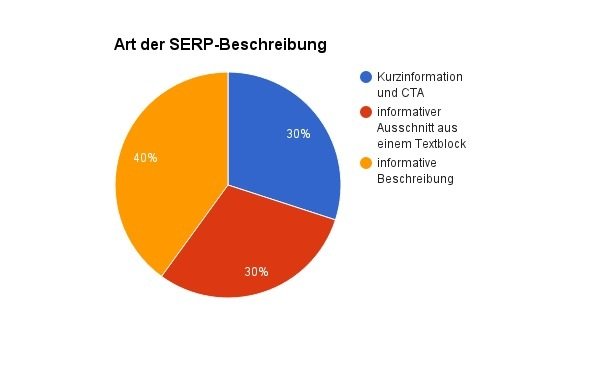

The keywords are more spread out here, but the main keyword appears in every description.

Here again the informative character of the results is evident: The origin of chia seeds and what they contain is discussed. There are also positive terms that are associated with health.
This means that the keyword should also be included in the description. Google prefers descriptions with an informative character that do not contain a call-to-action element. You should take this fact to heart when choosing your meta descriptions if your page is also informative in nature.
1.4 SERP description "chia seed recipes"
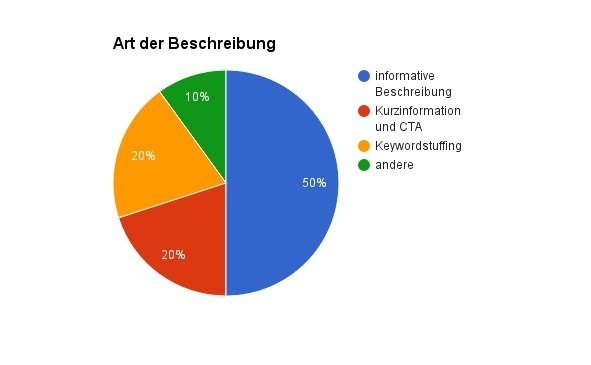
The type of description is more varied here. Although the informative description also predominates here, the descriptions can also differ from one another as the results pages deal with the recipe topic in a differentiated manner.
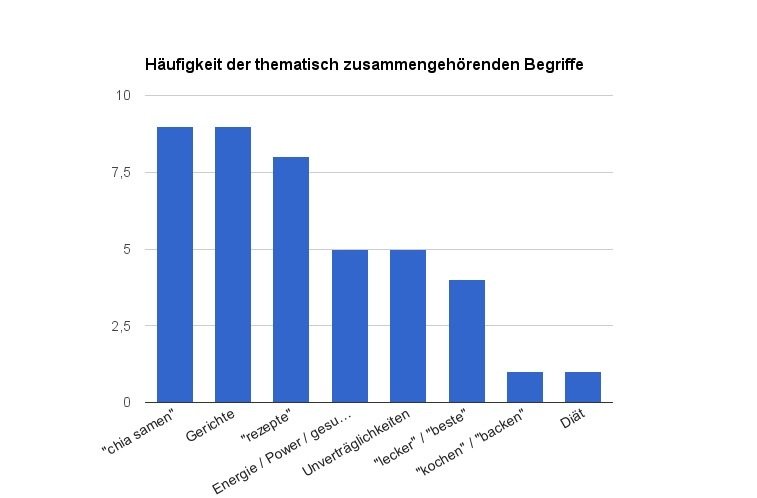
In the descriptions, there is an accumulation of subject terms that frequently occur in connection with "recipe". The individual terms are very diverse, see the following table. However, Google recognizes their commonality.
| Keyword | Frequency |
|---|---|
| chia seeds | 9 |
| recipes | 8 |
| energy / power | 3 |
| pudding | 2 |
| superfood | 2 |
| best | 2 |
| vegan | 2 |
| gluten-free | 2 |
| selection | 2 |
| smoothies | 1 |
| bread | 1 |
| jam | 1 |
| ice cream | 1 |
| Nutrients / Ingredients | 1 |
| Brand-KW | 1 |
2 Intention of the results page
2.1 Intention for "chia seeds"
"chia seeds" is a generic keyword whose search intent is most likely to be satisfied by basic information, definitions or explanations of terms. It is difficult to find out exactly what the searcher wants. Accordingly, Google offers results that are more holistic and informative. The first 3 results in the SERP snippet promise valuable information, all-encompassing topic coverage and are positive about the health-promoting effects of chia seeds. According to the SERP snippet, the other results treat the topic critically to very critically and sometimes mock the nutritional hype. Two other results promise to have examined the effects and side effects of the seeds.
2.2 Intention behind "chia seed recipes"
The searcher obviously already knows what chia seeds are and wants specific information on recipes. It should be clear why, for example, a store page that does not deal with recipes does not rank here. Google almost exclusively offers results for recipe pages, almost all of which have a promise in the SERP snippet. Emotional terms (delicious, healthy, simple) and numbers (9 recipes, 49 recipes,...) are used to "advertise" here. An informational character is not evident here. Only one result takes a critical look at chia seeds as a food. This seems logical, as the intention suggests that the searcher has a positive attitude towards the seeds and would like to test them, exchange experiences, etc.
3. type of website or type of provider
As with the intention and use of terms, the website types for the two keywords differ considerably.
3.1 Website types for "chia seeds"
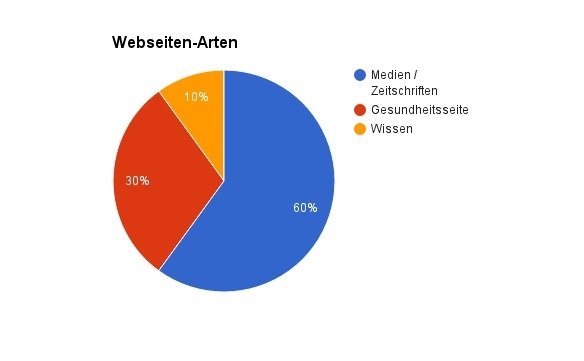
Most of the results come from publishers that originally came from the print sector. This is easy to explain: General information should be correct in order to create added value for search engine users. Google therefore chooses trustworthy sources. However, the first two results come from the page chia-samen.info, a keyword domain, with a Power*Trust of only 8 compared to the other result pages with values between 24 and 81. This suggests that the use of keywords in the domain / URL is more important than Power*Trust and that a specialized page is more likely to rank than a page that contains various topics.
However, you should not make the mistake of only creating keyword domains. This practice is already outdated and as long as these pages do not bring any added value, they will not rank well. Besides, you don't just want to rank for one keyword.
3.2 Website types for "chia seed recipes"
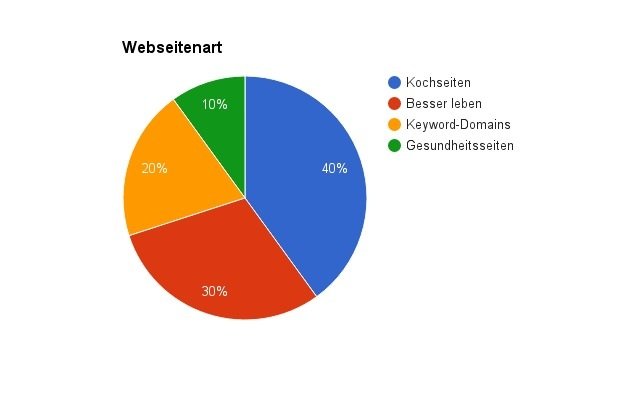
The field of providers is more mixed, although pure cooking sites and "live better" sites predominate. Here, too, there are two keyword domains whose Power*Trust of 6 and 8 is also below the average of 21. The highest Power*Trust value in this group is 36.
What does this tell us? The more specific a topic, the easier it is for "small" websites to rank highly. The more general the search query, the more trust the domain needs for good positions.
More specific search queries usually consist of at least 3 words, i.e. they are so-called long-tail keywords. Try to optimize your subpages for these longtail keywords.
4. backlink numbers
Backlinks are a ranking factor, that's for sure. How important this factor is, however, is not. It was interesting for us to find out whether there is a similarity in the number of backlinks in the first 10 results. However, this question could not be clearly answered with "yes" in our study.
4.1 Backlink numbers for "chia seeds"
We measured backlinks to the pages and to the domains. For the results pages, the values are between 14 and 506, average 143. The domains have backlink numbers between 716 and >30,000, average 11,595. This is also a sign that results pages with high trust tend to rank for general search queries, e.g. due to a high number of backlinks. Downward outliers make it clear that backlinks are only one of many ranking factors, but that they are particularly advantageous for highly competitive keywords.
4.2 Backlink numbers for "chia seed recipes"
The individual pages have backlink numbers between 1 and 91, average 17. The domains have backlinks with a number between 36 and 11,901, average 5,585. Clearly lower values than for the more general search query. "Smaller" sites therefore have the opportunity to rank well for specific search queries even with far fewer backlinks, as the search volume and also the competition are lower here.
5 Trust and Power*Trust of the domain
Trust reflects the trustworthiness of the site. Power*Trust is a key figure that multiplies the link strength (power) by the trust of the domain. The higher both values, the "better" the domain is.
5.1 Trust and Power*Trust of the domain "chia samen"

For "chia seeds" we found trust scores between 2 and 9 (average 5.3), which is balanced to high overall.

Power*Trust is between 8 and 81, with an average of 35, whereby the well-known publisher websites have significantly better values.
The backlinks play a major role in this metric, which is why it was to be expected that there would be no surprisingly low values here. What is particularly interesting for website operators here is where the websites in the first 10 positions have received backlinks for this keyword. It is worth checking this using link research tools, for example.
5.2 Trust and Power*Trust of the domain "chia samen rezepte"


As expected, the Trust and Power*Trust values are lower for "chia seed recipes". Trust: 2 to 6 (average 4) and Power*Trust:6 to 36 (average 20.8). This is in line with the results and findings above.
If your website is rather "small", it can rank well for niche keywords even with less Power and Trust.
6 Page structure, format and visuals (non-text elements)
6.1 Page structures and formats for "chia seeds"
| Position | Structure | structure | Advertising | Interaction | Visuals |
|---|---|---|---|---|---|
| 1 | clear, lots of text, holistic | consistent with headings, highlights, lists, few visuals | few, appropriate | Social media | Image |
| 2 | very clear, lots of text | consistent with headings, highlighting | little, appropriate |
Social media |
none |
| 3 | clear, lots of text, holistic, with references | consistent, with headings, highlighting. Color scheme not optimal, images and advertising | unobtrusive, appropriate | Donations, newsletters, comments | Images |
| 4 | clear, mediocre amount of text | consistent with headings and table at the end | Conspicuous and sometimes distracting | Social media, comments, print | images |
| 5 | clear, moderate amount of text | consistently with headings and author information at the end | conspicuous, partly inappropriate (remarketing) |
Social media, other articles from the provider, comments, print | Image |
| 6 | less clear, lots of distraction from advertising, videos and links to other articles | Different formatting and content types: Lists, text, advertising, videos, lots of distraction | a lot, inappropriate, intrusive | Video player, social media, comments | images, videos |
| 7 | clear, a lot of distraction from advertising | consistently with (short) different colored topics, links | a lot, inappropriate, intrusive | Video player, social media, other content | Images, videos |
| 8 | Very clear, mediocre amount of text | Consistent with headlines, text and images | little, inappropriate | Social media, comments | Images |
| 9 | clear, little text | with headings throughout, line width not optimal. Links to other content, references | none | none | Images |
| 10 | clear, moderate amount of text | consistent, although headings are difficult to recognize as such. Source section almost as long as text section | none | Social media, listen to article | Image |
These 10 results have in common that they are clearly to very clearly structured and show the visitor directly what the main content is. The top results (1-3) are pages with a lot of text and a holistic treatment of the topic. From position 4 onwards, the amount of text decreases and the frequency of sometimes inappropriate and intrusive advertising increases. We have gained the impression that Google tends to show clear, holistic texts for this keyword rather than articles from sometimes very prominent media. You can therefore assume that, even if you are not "Der Spiegel" or "Focus", you can rank well for generic keywords with good, holistic texts.
Learnings:
- Rather long text
- rather holistic
- Lists and few but good visuals help
- Avoid distraction through advertising and references to other articles
- Good structure in which different content elements can be clearly distinguished from one another
- Leave white space so that the eye can find its way around
- Optimize contrast between foreground and background
6.2 Page structures and formats for "chia seed recipes"
The structure of the page is a very soft factor and is particularly important for human visitors. According to Fishkin's theory, the first 10 result pages are very similar in terms of content and structure. Our test revealed the following:
| Position | Structure | structure | Advertising | Interaction | Visuals |
|---|---|---|---|---|---|
| 1 | very clear, lots of text | consistent with headlines and texts, images | little, appropriate | Social media | images |
| 2 | clear, lots of text | Consistent with headlines and texts, images | Skyscraper | Search, CTA elements | Claim, images |
| 3 | clear, hardly any text, as overview page | consistently with individual recipes as teasers | very much, inappropriate | Search, sorting, filtering, tags | Recipe images |
| 4 | clear, moderate amount of text | consistent with headings, lists, texts, images | above the fold almost full screen | Social media, comments | images, video |
| 5 | clear, with table of contents of the page and lots of text | consistent with headings, texts, lists, images and advertising | a lot, outside and in the main content area | difficult to recognize Social media | images |
| 6 | very clear with table of contents of the page, medium amount of text | Consistent with headings, text, images, lists, advertising | Skyscraper, otherwise inconspicuous in the main content area | Newsletter, other suitable articles, social media | images |
| 7 | Very clear, lots of text | consistent with headlines, text, images | unobtrusive, for own products | Recipe PDFs, store | images |
| 8 | clear, little text, as overview page | consistent with individual recipes as teasers | unobtrusive, little | social media, large slider | Recipe images |
| 9 | clear, little text, as overview page | with individual recipes as teasers throughout | available | Social media, newsletter, large slider | Recipe images |
| 10 | clear, rather less text | Consistent with headlines, images, advertising | eye-catching and intrusive | Commentary, social media, print | 1 image |
The long-tail keyword has different page characteristics to the generic keyword above. Nevertheless, we also find a clear to very clear structure with a rather high amount of text. However, Google offers different page types as results for this search intention: Recipe pages and recipe overview pages. Clarity and consistency, also in the structure, allow these pages to rank highly. There is considerably more advertising here, most of which is unpleasant (from result 3). However, visitors looking for detailed information will probably put up with this. Overall, the ability to interact is higher here, but advertising and links to other content are very distracting.
Learnings:
- More specific texts
- rather long
- Use images
- Advertising is easier to place here, is more likely to be accepted
- Clarity in layout and structure!
- Better options for the call to action
- More "gimmicks" possible with content types
By the way: Our web designers from Stuttgart will be happy to help you create the perfect design for your website!
7. word count, scope, specification and readability (WUSL)
Evaluating these factors still requires the human eye. However, as search engines try to imitate human thinking and behavior, these factors will be increasingly included in the evaluation of a page. We were interested in whether the first 10 results differed significantly in word count, volume, specificity and readability (WUSL).
7.1 WUSL for "chia seeds"
| Position | Length (word count) | Scope (1 little, 10 full) | general(1) or specific(10)? | Readability (1 very difficult, 10 super easy) |
|---|---|---|---|---|
| 1 | 3110 | 10 | 3 | 7 |
| 2 | 952 | 8 | 2 | 7 |
| 3 | 9287 | 10 | 2 | 10 |
| 4 | 1200 | 6 | 2 | 7 |
| 5 | 1906 | 8 | 3 | 7 |
| 6 | 2427 | 3 | 5 | 8 |
| 7 | 1396 | 4 | 8 | 8 |
| 8 | 1128 | 3 | 2 | 7 |
| 9 | 1183 | 4 | 2 | 5 |
| 10 | 1814 | 4 | 8 | 7 |
| average | 2440 | 6 | 3,7 | 7,3 |
| Median | 1605 | 5 | 2,5 | 7 |
| Result | Rather a lot of text | moderately extensive | Rather general | Rather easy to read |
Based on the first 10 results, the texts are rather long and moderately extensive. However, as far as the first 3 results are concerned, you can see that both word count and volume are particularly high. The information is quite general in nature, as you would expect from a generic keyword.
7.2 WUSL for "chia seed recipes"
| Position | Length (word count) | Scope (1 little, 10 full) | general(1) or specific(10)? | Readability (1 very difficult, 10 super easy) |
|---|---|---|---|---|
| 1 | 1476 | 7 | 6 | 9 |
| 2 | 2969 | 6 | 8 | 8 |
| 3 | 1077 | 10 | 10 | 8 |
| 4 | 1015 | 7 | 7 | 10 |
| 5 | 1110 | 3 | 4 | 8 |
| 6 | 1591 | 4 | 6 | 7 |
| 7 | 2831 | 8 | 8 | 8 |
| 8 | 419 | 9 | 6 | 6 |
| 9 | 456 | 9 | 8 | 9 |
| 10 | 2083 | 9 | 8 | 8 |
| average | 1502 | 7,2 | 7,1 | 8,1 |
| Median | 1110 | 7 | 7 | 8 |
| Result | Rather a lot of text | Rather extensive coverage of all suggestions | Rather specific content | Rather good and easy to read |
The first 10 results contain fewer words in total than the example above. The scope is higher here. However, it is important to understand that the scope here is limited to recipes. This means that the subject area is already very limited. This naturally also increases the level of specification. Readability is easier here than with the generic keyword. Our assumption is that with a specific search query there are more possibilities to work on a topic. Overview pages, for example, are very different in nature to full article pages. The result is much less clear here.
8 Conclusion
If you want to rank for a keyword, you should take a close look at the first 10 results: Why does Google assign the highest relevance to these pages in particular? What types of content are used? What is the aim of the website? What is not on the other pages but is related to the topic?
Create a page that behaves similarly to the other pages, but is not a copy of them.
Use a WDF*IDF analysis to find terms that belong to this topic. This illustrates a holistic treatment of the topic and is a relevance factor.
Last but not least, you should take a look at the backlink profiles of your competitors: Who is linking to them? Could you pick up a backlink or two here?










